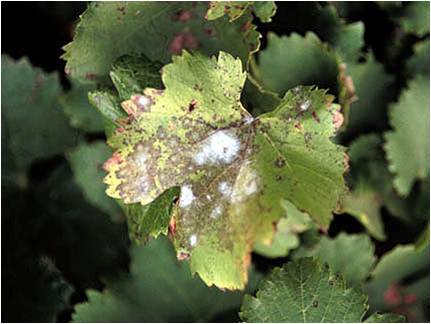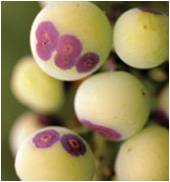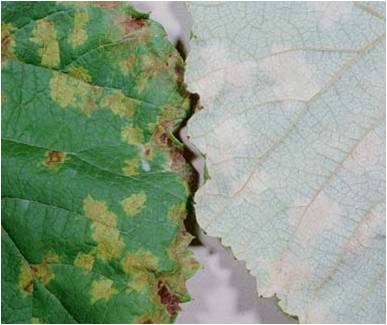State-wise area, production and productivity of grapes are given in Table below..
State | Area (‘000 Ha.) | Production (‘000 MT) | Productivity (MT/Ha.) |
Maharashtra | 32.50 | 911.60 | 28.10 |
Karnataka | 10.00 | 169.70 | 16.90 |
Tamil Nadu | 2.40 | 51.70 | 22.00 |
Punjab | 1.40 | 36.70 | 27.00 |
Andhra Pradesh | 1.50 | 29.40 | 20.00 |
Haryana | 1.10 | 6.40 | 5.70 |
Madhya Pradesh | 0.10 | 2.60 | 25.00 |
Mizoram | 0.20 | 0.60 | 3.20 |
Jammu & Kashmir | 0.20 | 0.30 | 1.60 |
Others | 0.10 | 0.60 | – |
TOTAL | 49.50 | 1209.60 | 24.40 |
For Dry Area
For making raisins: Thompson Seedless, Black Sahebi
For raw eating: Thompson Seedless, Beauty Seedless, Black Sahebi, Anab-e-Shahi,Thompson Seedless: Bunches are big, equal sized grape, the grape is medium long, green color fruits turn golden at maturity, fruit is seedless, hard and good taste, late maturing variety.
Varieties cultivated in different regions of India.
Regions | States | Varieties cultivated |
Region – I. (Northern India) | Haryana, Punjab, Delhi, Western Uttar Pradesh, Rajasthan | Thompson Seedless, Perlette, Beauty Seedless, Anab-e-Shahi, Black Hamburg, Black Prince, Dakh, Foster’s seedling, Kandhari, Khalili, Pandhari Sahebi, Watham Cross, Pusa Seedless, Hur, Black Muscat, Early Muscat, Banquiabyad, Cardinal, Kairon, |
Region – II (Peninsular India) |
| Anab-e-Shahi, Thompson Seedless, Cheema Sahebi, Pandari Sahebi, Gulabi, Bhokri, Kali Sahebi, Sonaka & Tas-A-Ganesh(clones of Thompson seedless).jambo,Read globe, Crimson,King Berry,Ara 59. |
Region – III (Peninsular India) |
| Bhokri, Anab-e-Shahi, Gulabi, Bangalore Blue, Black Champa, Convent Large Black, Angur Kalan, Taifi Rosovi, Coarna Resia, Queen of vineyard, Kandhari, Black Prince, Muscat, Pachadraksha |
List of commercial varieties utilized for specific purposes is given in the following:
Category | Varieties |
Table grapes | Anab-e-Shahi, Bangalore Blue, Beauty Seedless, Bhokri (Pachadrakshi), Cheema Sahebi, Delight, Gulabi (Panneer Drakshi, Muscat Hamburg), Himrod, Kali Sahebi,Kandhari, Khalili, Pandari Sahebi, Perlette, Selection 94, Pusa Seedless and Thompson Seedless. |
Raisin Grapes | Thompson Seedless, Arkavati |
Wine Grapes | Bangalore Blue, Thompson Seedless and Arka Kanchan |
Commercial varieties can be grouped under four categories based on color and seeds:
Coloured seeded | – | Bangalore Blue, Gulabi (Muscat) |
Coloured seedless | – | Beauty seedless and Shared Seedless,jambo,Crimson ,Read globe,Ara . |
White seeded | – | Anab-e-Shahi, Dilkhush (clone of Anab-e-Shahi) |
White seedless | – | Perlette, Pusa Seedless, Thompson Seedless and its clones (Tas-A-Ganesh, Sonaka & Manik Chaman). |
Soil-
Climate –
Vitis riparia, V. rupestris
2.Nematode resistant rootstock
Dogridge, Salt creek
3.Saline tolerant : Solanis, 1616
Time of sowing:
Transplanting of prepared root cutting is done in December to January month.
Spacing:
By Knifing method, use spacing of 3mX3m and by arbour method use spacing of 5m X 3m. For Anab-e-Shahi variety, use a spacing of 6m X 3m.
Sowing depth:
Cuttings are planted at the depth of 1m.
Nutrition
Recommended doses of nutrients for different varieties under different agro-climatic regions are given in table below: Recommended nutrient doses (kg./ha.) for different varieties of Grape
Variety | Region | N | P2O5 | K2O |
Anab-e-Shahi | North India | 366-600 | 300-550 | 183-1200 |
Telangana | 435 | 305 | 784 | |
South interior Karnataka | 500 | 500 | 1000 | |
Beauty Seedless | North India | 165 | – | – |
Cheema Sahebi | Maharashtra | 600 | 240 | 120 |
Gulabi, Himrod, Perlette | North India | 444-715 | 457-1332 | 460-1000 |
Thompson Seedless,jambo,crimson,sonaka,ssn,Read globe. | North India | 444-1100 | 1332 | 1332 |
Maharashtra | 666-1000 | 500-888 | 666-800 | |
South interior Karnataka | 300 | 500 | 1000 |
Fertilizer Requirement (gm/tree)
| Age (in years) | Cow dung (kg) | CAN (gm) | SSP (gm) | MOP (gm) |
| 1st year | 20 | 400 | 1500 | 250 |
| 2nd year | 35 | 500 | 2500 | 350 |
| 3rd year | 50 | 600 | 3500 | 500 |
| 4th year | 65 | 800 | 4000 | 650 |
| 5th year | 80 | 1000 | 4500 | 800 |
Application of Stomp@800ml per acre is done as the pre-emergence in the first fortnight of March after thorough ploughing and then spraying of Gramoxone 24 WCS (paraquat) or Glycel 41 SL (glyphosate)@1.6 ltr/acre in 150 ltr water is done as post emergence when the weeds attain the height of 15-20cm.
| Time | Number |
| After pruning in the 1st fortnight of February | One irrigation |
| First week of March | One irrigation |
| After fruit set in April till 1st week of May | At 10 days interval |
| During the rest of May | Weekly interval |
| June | 3 or 4 days interval |
| July to October | Irrigate when prolonged dry spell or rainfall is in sufficient |
| November to January | One irrigation if soil gets extremely dry |
The training system and intensity of pruning recommended for different varieties is given below:
Varieties | Distance of planting | System of training | No. of canes to be left on each vine | No. of buds to be left per cane |
Thompson Seedless | 2 x 3 | Kniffin | 16-20 | 8-10 |
Beauty Seedless | 2 x 2 | Head | 16-20 | 3-4 |
Anab-e- Shahi | 3 x 6 | Arbour | 60-80 | 5-6 |
Perlettee | 3 x 3 | Head, Kniffin | 30-40 | 3-4 |
1.Bower
2. Kniffin (also called Espalier System)
Advantages of Kniffin System over Bower System:
The main drawback is that yield is about half of what is obtained on a bower system. Though the vine canopy is exposed to light, the lower laterals are less productive due to shading by the foliage on the upper laterals. Damage to the branches is more due to sunburn and birds.
3.Telephone System
Advantages of Telephone System over Bower System:
Disadvantages of Telephone System over Bower System :
4.Head System
The return on investment made is less as compared to the Bower system. Size of the berries produced on this system is larger as compared to that of other systems. Incidence of diseases is much less on this system
In general four bud levels of pruning for Muscat, Pachi Draksha, Bangalore Blue, Anab-e-Shahi and Arka hybrids and two bud levels for Thompson Seedless may be adopted. It is better to decide the level of pruning as per bud forecasting technique. Weak and immature canes should be pruned to one or two buds to induce vegetative growth.
The prevailing pruning practices in India can be broadly grouped into the following categories:
1.Single Pruning- Single cropping
2.Double pruning – Single cropping
Summer crop: Pruning in December – January and harvesting during April – May.
Monsoon crop: Pruning in May-June and harvesting during August – September
Special practices
Dip the clusters in solution containing Brassinosteroid 0.5 ppm and GA3 25 ppm at 10-12 days after fruit set to maintain vigour, yield and quality parameters.
Double pruning for double cropping in Muscat Hamburg (Panneer)
1.Shoot thinning
5. Nipping
Nipping is practised by removing the emerged shoots from axillary buds and terminal growth at 12th to 15th bud position from the base.
6.Cluster and berry thinning
Thinning of excess number of clusters prior to anthesis and thinning the compact bunches by removing 20 – 30 per cent of the berries at pea stage (3-4 mm size berries) using hand scissors should be followed.
Special practices
1 Phosphorus
|
| Deficiency Symptoms |
Pigmentation seen in old leaves; leaf growth rate will be affected |
| Correction Measure |
Soil application of super phosphate or foliar spray of DAP@1-2% |
2.Potassium
|
| Deficiency Symptoms |
|
| Correction Measure |
|
3.Calcium
|
| Deficiency Symptoms |
|
| Correction Measure |
Foliar spray of CaSO4 1% or soil application of gypsum @ 50 kg/ha. |
4.Magnesium
|
| Deficiency Symptoms |
|
| Correction Measure |
|
5.Boron
|
| Deficiency Symptoms |
|
| Correction Measure |
Foliar spray of Borax 0.2% at soil application of Borax 25-50 g/plat. |
6.Iron
|
| Deficiency Symptoms |
Leaf veins remain green interveinal portion turns yellow young leaves small but not deformed. |
| Correction Measure |
Foliar spray of 0.5% FeSO4 |
7.Manganese
|
| Deficiency Symptoms |
|
| Correction Measure |
|
8.Zinc

Deficiency Symptoms
Poor fruit set and stunted shots with small, misshapen leaves foliar application of zinc is the most effective method for treating Zn deficiency.
Correction Measure
Symptoms of damage
Management
2. Mealy bug: Ferrisia virgata
Symptoms of damage
Management
3.Stem girdler-Sthenias grisator
Symptoms of damage
Management
4. Flea beetles Scelodonta strigicollis
Symptoms of damage
Management
5.Thrips –
Symptoms of damage
Presence of silvery white scorchy patches on the leaves
Management
6.Berry plume moth: Oxyptilus regulus
Symptoms of damage-
Management-
7. Nematodes –
Management-
1.Powdery mildew- Uncinula necator

Symptoms
Management
2.Anthracnose / Birds Eye Spot –Gloeosporium ampelophagum Elsinoe amphelina


Symptoms
Management
3.Downy mildew – Plasmopara viticola

Management
Post Harvest Diseases
1.Anthracnose/ Bird eye spot: Elsinoe ampelina
Symptoms
Management:
2.Botrytis Bunch Rot or Gray Mold of Grape: Botrytis cinerea
Symptoms
Management:
3.Blue mould rot: Penicillium digitatum
Symptoms
Management:
4.Rhizopus rot: Rhizopus nigricans
Symptoms
Management:
Harvesting is done when fruits are fully matured.
Thompson Seedless and its clones : 25 t / ha/ year
Muscat Hamburg (Panneer) : 30 t / ha / year
Red Globe : 20 t / ha / year
Crimson Seedless : 15 t / ha / year
Anab-e-Shahi and Arka hybrids : 20 t / ha / year
The cost components of such a model along with the basis for costing are exhibited in
Annexure
A summary is given in the figure below. The project cost works out to Rs. 3.20 lakhs.
Figure-I : COST OF PROJECT
Project Cost:
(Amount in Rs.)
Sl. No. | Component | Proposed Expenditure | |
1. | Cultivation Expenses |
| |
| (i) | Cost of planting material | 10,000 |
| (ii) | Manures & fertilizers | 9,000 |
| (iii) | Insecticides & pesticides | 4,000 |
| (iv) | Cost of Labour | 8,800 |
| (v) | Others, if any, (Power) | 3600 |
|
|
| 35,400 |
2. | Irrigation |
| |
| (i) | Tube-well/submersible pump | 56,000 |
| (ii) | Cost of Pipeline | – |
| (iii) | Others, if any, please specify | – |
|
|
| 56,000 |
3. | Cost of Drip/Sprinkler | 35,000 | |
4. | Infrastructure |
| |
| (i) | Store & pump house | 30,000 |
| (ii) | Labour room | – |
| (iii) | Agriculture Equipments | 10,000 |
| (iv) | Others, if any. Please specify (Bower system) | 1,20,000 |
|
|
| 1,60,000 |
5. | Land Development |
| |
| (i) | Soil Leveling | 4000 |
| (ii) | Digging | – |
| (iii) | Fencing & gates | 29600 |
| (iv) | Others, if any, please specify | – |
|
|
| 33,600 |
6. | Land, if newly purchased (Please indicate the year) | @ | |
| Grand Total | 3,20,000 | |
@Cost of newly purchased land will be limited to 10% of the total project cost.
